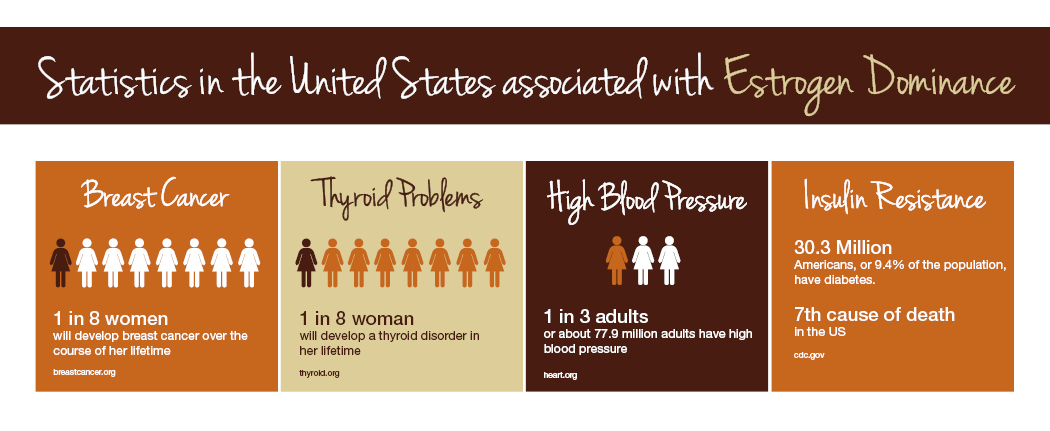Are you struggling with mood swings, weight gain, or low libido? If so, you could be dealing with a hormone imbalance called ‘estrogen dominance’. Estrogen is one of the most important female reproductive hormones and is crucial for day-to-day functioning. It regulates the menstrual cycle, improve the thickness and quality of the skin, helps regulate cholesterol production in the liver, contributes to bone health, and more. Without it, you end up with symptoms of menopause, like vaginal changes, hot flashes, moodiness, irregular periods, and more.
But, too much of a good thing causes biological chaos, in the case of high estrogen in women.
Estrogen dominance can wreak havoc on your whole body!
The link between estrogen dominance and cancer
Having too much estrogen, and not enough progesterone–known as estrogen dominance–is not only linked to a long list of frustrating symptoms; it also puts you at risk for a variety of chronic issues. By far the greatest risk associated with estrogen dominance is hormone-dependent cancers such as estrogen receptor positive breast cancer in women. The statistics are staggering, one in eight women will develop breast cancer in her lifetime.
Estrogen dominance and thyroid issues
Thyroid issues can also occur because excess estrogen blocks the thyroid hormones from hitting their receptor sites and doing its job. Excess estrogen can wreak havoc on your body if it’s not in proper balance with your other reproductive hormones, mainly progesterone. Since progesterone is a natural diuretic; estrogen dominance can also lead to high blood pressure. Properly balanced progesterone will also stabilize blood sugar; therefore, estrogen dominance has been linked to insulin resistance and diabetes.
Could I be estrogen dominant?
Are you struggling with mood swings, weight gain, or low libido? If so, you could be dealing with a hormone imbalance. Similar to low progesterone, estrogen dominance can cause a variety of symptoms, some obvious and some subtle.
High estrogen symptoms
- PMS
- Weight gain (particularly in hips, midsection, thighs)
- Fibrocystic breasts
- Fibroids
- Endometriosis
- Abnormal menstrual cycles
- Fatigue
- Reduced sex drive
- Depression
- Anxiety
- Bloating
- Breast tenderness
- Mood swings
- Brain fog
- Insomnia
What causes estrogen dominance?
Estrogen dominance occurs when there is too much estrogen circulating throughout the body when compared to progesterone. There are many factors that can contribute to this imbalance, here are a few of them:
Being overweight
Excess body fat is one of the main causes of estrogen dominance. Not only does fat tissue absorb and store estrogen in your bloodstream, it also synthesizes estrogen from your other hormones. As expected, the more fat cells you have, the more estrogen you will make. The more estrogen you make, the more fat you store, and the cycle continues.

Portrait of middle-aged blond woman having a migraine
Stress
Chronic stress is one of the main reasons women become estrogen dominant. When you are stressed, or overly busy, your cortisol levels go sky high and your body must use up its progesterone to keep up, which will ultimately deplete your “oh so helpful” hormone, progesterone. As more progesterone is used for cortisol production, less is available to balance estrogen – leading to increased estrogen levels. Also, excess estrogen will cause the pancreas to over produce insulin, so you can’t burn fat efficiently, no matter what you are eating!
Environment
Thousands of man-made products contain xenoestrogens, industrial chemicals that mimic the behavior of estrogens and disrupt your hormone balance. You would literally have to live in a bubble to escape the excess estrogens we’re exposed to in our daily, modern environment. They’re everywhere–in our water, our food, personal care products, furniture and clothes. You encounter a shocking number of these hormone imbalancing xenoestrogens each day, without even knowing it.
Birth control pills and hormone replacement therapy (HRT)
Birth control pills can stop ovulation, increase inflammation, supresses hormones needed for optimal bodily functions – and so much more. Erratic periods and heavy bleeding are often a result of estrogen dominance. Hormone replacement therapy medications and most oral contraceptives only add more estrogen on top of excess estrogen, without the balance of progesterone. Progesterone balances the effects of estrogen, and without enough, you end up with symptoms of estrogen dominance.
 Perimenopause
Perimenopause
This is generally the time when your body will prepare for menopause. Ovulation starts to slow down and your progeseterone levels also drop, which can lead to estrogen becoming the dominant hormone.
Imbalanced gut bacteria
There is an estrogen-metabolizing bacteria in your gut which helps to keep estrogen at a more stable level. These bacteria are referred to as estrobolome, and they help to determine whether or not estrogen is removed from the body. When these gut bacteria aren’t functioning properly, there can be an overproduction of an enzyme called beta-glucuronidase. With this, extra estrogen can be re-absorbed by the body when it should have been removed.
8 Ways to Reduce Estrogen Dominance
1. Eat a whole food nutrient dense diet
Eliminate all toxic, processed foods from your diet that contain hidden estrogens, including conventional meat, dairy products, and produce. Choose grass-fed, pasture-raised, and organic whenever possible to avoid added hormones, pesticides, and fertilizers used in conventional farming methods. It’s also important to consume adequate amounts of fiber. Fiber helps remove excess estrogen from the body and helps stabilize blood sugar levels which is critical for optimal hormone balance.
2. Filter your water
Thanks to runoff and pollution, hormone-disruptors are rampant in our water supply. Bottled water is equally problematic. Estrogenic chemicals in plastic bottles leaches out into the water. To protect your water, install water filters on all your facets and shower heads. Look for a triple-stage filter: a sediment filter, a ceramic filter, and an activated charcoal filter.
3. Quit birth control
Talk to your functional medicine doctor about non-hormonal birth control options.
4. Exchange your personal care products
Switch out chemical-filled personal care products for safer versions that are free and clear of any synthetic compounds such as parabens and sulfates.
In fact some of these synthetic ingredients are known to mimic estrogen in the body. Some of the leading toxic culprits to look out for and remove include:
– Parabens
– Phthalates
– 4-Methylbenzylidene
– Lead
– Triclosan
– Petrochemicals
 5. Get moving
5. Get moving
Exercise can speed up the liver’s detox processes, sharpen insulin sensitivity, boost weight loss, help mitigate mood swings associated with estrogen dominance, and reduce levels of stress hormones in the body. Choose lower-impact exercises as opposed to high-impact, which can raise cortisol levels.
6. Reduce stress
Practice relaxation techniques such as meditation, yoga, and gratitude. Start a de-stressing practice that will free up that pregnenolone for progesterone. It is also important that you make sure you’re getting adequate sleep at night to let your body detox and recover from the stresses of the day.
7. Take supplements
Magnesium: Magnesium allows the body to absorb calcium and regulates the pituitary gland, which in turn regulates hormone levels. It has also been known to have a calming effect which will help reduce stress and aid with sleep. Vitamin B6: Vitamin B6 helps to regulate your hormones and can help reduce blood estrogen levels and result in improvements in PMS symptoms.
8. Let Bebalanced help!
Until you balance your hormones, you will have problems with stubborn weight, mood, sleep, energy, and a host of other frustrating symptoms. The BeBalanced program is a simple, effective way for the body to correct hormone imbalances – naturally. Our natural hormone balancing program works with your body, unlike traditional HRT, which has risks and often causes more weight gain and symptoms. Our mission at BeBalanced is to help you be healthy, be happy, and be you again!


